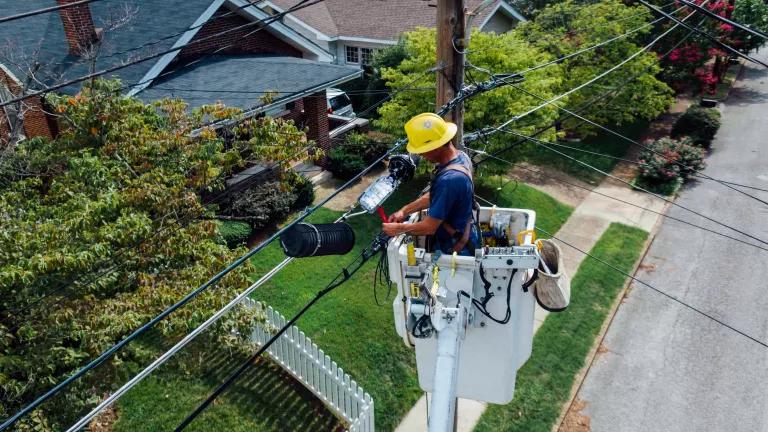Congress Gets Us to the Start Line for Transmission
FERC and the Department of Energy must deliver long-range transmission lines and help us all win the race to a clean energy future.

When I raced sailboats on Lake Michigan, so much of the action took place before the start. Each boat would tack back and forth, angling to get to the line just as the horn sounded. In our effort to build the electric grid we need for the future, that’s where we are today.
In both the bipartisan infrastructure bill and this summer’s climate law, Congress got us to the starting line, providing vital investments to support electricity transmission projects. This funding will help upgrade our outdated grid and speed the transition to clean, renewable energy.
But these investments won’t provide all that’s needed to deliver the long-range transmission lines needed to build the grid we need for the 21st century.
And so, the horn has sounded for the Federal Energy Regulatory Commission (FERC) and the Department of Energy (DOE). Each must now deliver the much-needed standards to build on the upcoming federal investments and make sure those investments deliver the results needed.
After all, as the record heat and strong storms this summer demonstrate, utilities and grid operators need to put in place a stronger, more nimble electricity system to cope with the challenges of a changing climate. One key to a more reliable and resilient grid is more and better electricity transmission.
Stuck in the queue
It is clear that we need to transition away from fossil fuel power sources that worsen climate change and to invest in a power grid that allows us to maximize the use of wind and solar power. Right now, there is almost 1 terawatt of renewable energy waiting to interconnect to the grid, enough power for tens of millions of homes. Many of these projects will never be built, the victim of arcane and often-outdated rules governing how to connect them to the grid. A much more robust transmission system would go a long way toward adding these wind, solar, and storage resources more quickly to the grid, while helping consumers, the environment, and grid reliability.
While the need for more long-distance transmission lines and better rules for interconnecting generation has been clear for years, grid operators and federal policies have failed to produce results. Without the ability to easily interconnect large amounts of clean energy and move it from remote areas where it is produced to cities and towns—and in some cases, across different transmission regions of the country—keeping the lights on and air conditioners running will become increasingly difficult.
Congress took important steps forward with two pieces of legislation designed to improve grid reliability
The Infrastructure Investment and Jobs Act, signed into law last November, allocates about $5 billion for new or expanded transmission, including $2.5 billion to support large-scale regional and interregional transmission projects. The DOE is using its new financing authorities to speed construction of high-capacity transmission lines with priority given to projects that improve grid resilience and reliability, facilitate interregional transfer of electricity, lower electric sector greenhouse gas emissions, and use advanced technology.
The law also expands the Smart Grid Investment Grant program, which funds investments that improve the flexibility of the grid. These include upgrading existing transmission and distribution systems and other actions, like deploying energy storage. The Inflation Reduction Act, which became law in August, includes about $2.9 billion for transmission development—including $2 billion in direct loans for transmission projects and $760 million in grants for siting of transmission projects. Unfortunately, this climate legislation didn’t include the production tax credit for transmission that would’ve provided a major boost for large-scale transmission. But the more limited funding that is in the bill will help more projects move more quickly through the approval process and improve their cost-effectiveness.
The DOE is also moving forward
The DOE is working on transmission initiatives, in part to implement the new laws. For example, it created a new Grid Deployment Office to help improve electricity delivery and reliability and to upgrade the grid and critical electricity-generating facilities.
In addition, DOE has:
- Issued a Notice of Intent outlining its Building a Better Grid initiative, which consolidates new and existing authorities to support the deployment of nationally significant transmission projects and grid upgrades;
- Issued a request for public input on the $2.5 billion Transmission Facilitation Program to help build out critical new transmission lines across the country;
- Issued a request for public input on a $2.3 billion grant program to strengthen and modernize America’s power grid against wildfires, extreme weather, and other natural disasters exacerbated by the climate crisis;
- Launched the Interconnection Innovation e-Xchange, a partnership funded by the infrastructure legislation that brings together stakeholders to promote clean energy grid connections.
What about FERC?
One of FERC Chairman Richard Glick’s top priorities is reforming the commission’s rules to reduce barriers to the new transmission development that is needed to facilitate the changing power grid. Getting these rules right is necessary to realize the goals of the infrastructure and climate legislation, lower electricity costs, and improve reliability.
First out of the gate was FERC’s proposal this spring to improve its transmission planning rules for the first time in more than a decade. NRDC, the Sustainable FERC Project, and other public interest groups support FERC’s direction here. While the proposal is a good start, we encourage FERC to improve it by mandating long-term regional planning with specific criteria and the types of benefits that new transmission will bring to customers.
FERC is also tackling the thorny issue of how to interconnect new power plants to the grid, and is seeking comment on its proposal. Reforming this complex and delay-filled process will be vital to unlocking the enormous potential for clean energy to connect to the grid.
Finally, we continue to urge the commission to develop new standards for planning transmission that bridges different regions of the country. These interregional power lines are critical for sharing power across large areas, increasing access to clean energy, and maintaining grid reliability and resilience to extreme weather events.
Momentum is building—finally!—for the development of the transmission infrastructure necessary to enable more clean energy and allow the grid to withstand the challenges posed by extreme weather.
Congress has acted and federal regulators are taking the first steps to do their part. Now it will be up to officials at FERC and DOE to complete the race, ensuring that states, public service commissions, grid operators, and utilities have the tools to usher in the upgrades needed to ensure the clean, reliable, and resilient electrical system we want and need.




